Amai, a conch piercing like that looks super cute! But doesn't that hurt?
Pain is nice, but placing a piercing will never feel good. Pain is something that everyone is going to experience differently. For some, it might be a huge pinching sensation, while you might feel a small prick. To give you an idea about which piercings hurt the most, we have compiled this list of the 10 most painful piercings in consultation with our piercers. Find out all about their pain scores and aftercare processes in this Inksane blog.
Nipple piercing pain
We hate to break it to you, but if we're really honest ... a nipple piercing is one of the most painful piercings you can get as a woman. If you go looking up some experiences online, you'll quickly find very different opinions. As always, pain is relative. Some people are going to experience a nipple piercing as tremendously painful, while others find it just a prick. Your experience depends entirely on the sensitivity of your own nipple. While placing this piercing, we pierce through the nerves. This is a different sensation compared to piercing through cartilage or skin.
1. Nipple piercing
At number one we like to immediately place the famous nipple piercing. Many women and men find this one of the most painful piercings. Here we pierce a rod through the base of the nipple with a small stone or ball on either side. Only after the piercing is fully healed can you change the rod to a ring. The reason why this piercing is so painful is because the nipple is a very sensitive area.
The healing process of this piercing can take as long as nine to 12 months. It is important to take good care of your piercings during this process. This means cleaning properly, avoiding intimate contact and not wearing tight-fitting clothing. After the pain and swelling is over, you can finally enjoy your amazing nipple piercings.
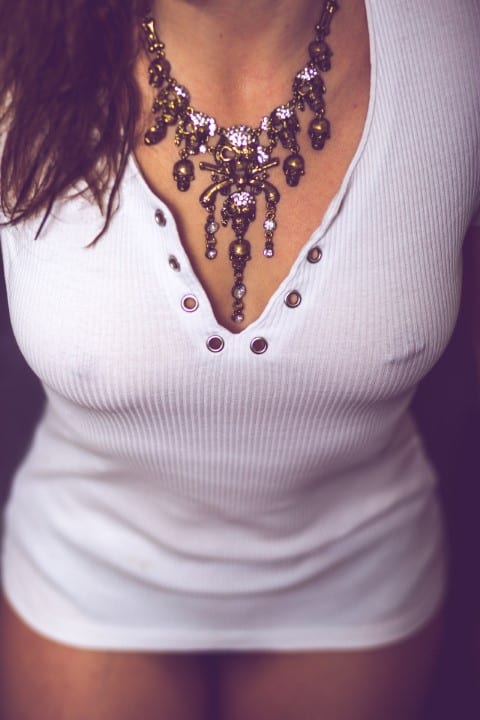
2. Industrial piercing
The industrial is also a piercing that will quickly score a 10 out of 10 on our pain score. It involves piercing two holes separately through the top crease of your ear. Twice pain, in other words. This piercing is going to connect the two sides of your ear using a rod, which can be a weird feeling for some.
Unfortunately, this piercing is not feasible for everyone. This is because you must have enough room in the crease of your ear. Is this the case with you? No worries! You can easily solve this problem by getting 2 helixes pierced, and then connecting them later with a nice chain.
An industrial also takes a long time to heal. It is actually 2 wounds connected to each other. Our golden tip is: Hurry and haste is seldom good. So take your time when taking care of it and be patient. This way you will get a beautiful healed piercing. Now, go rock that industrial!
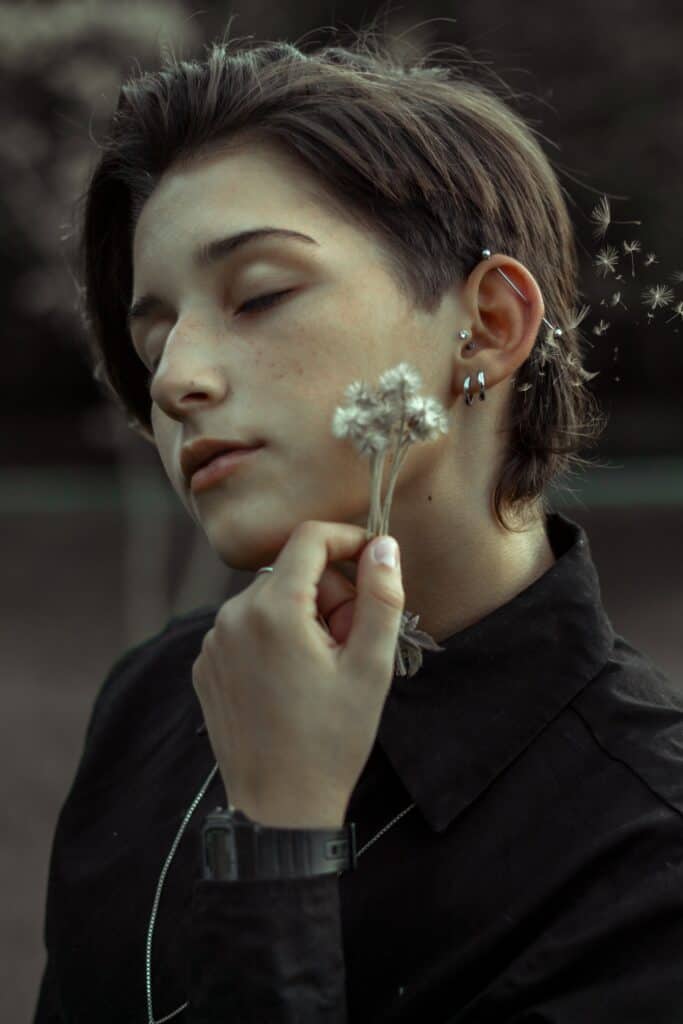
3. Smoke piercing
At number three, then, is the smoke piercing. This original piercing is placed through the anthelix of your ear (the top little arch in the middle of your auricle). This can be quite a painful piercing, but everyone is going to experience pain differently. On our pain rating, the smoke piercing gets a six out of ten.
Many choose a smoke because it stands out nicely and you can personalize it with fun jewelry. During piercing, you may feel a weird pressure on your ear, but that pain will pass in no time. After piercing, it is best to sleep on your non-pierced ear for a while.
This piercing also depends on your anatomy. Some have no or too little room to pierce a bar through their cartilage. Do you have too little space or it's not quite your style? Then that's no problem! You can also opt for a fake smoke, where we place a piercing horizontally with then a particle of the jewel at the back of the ear.
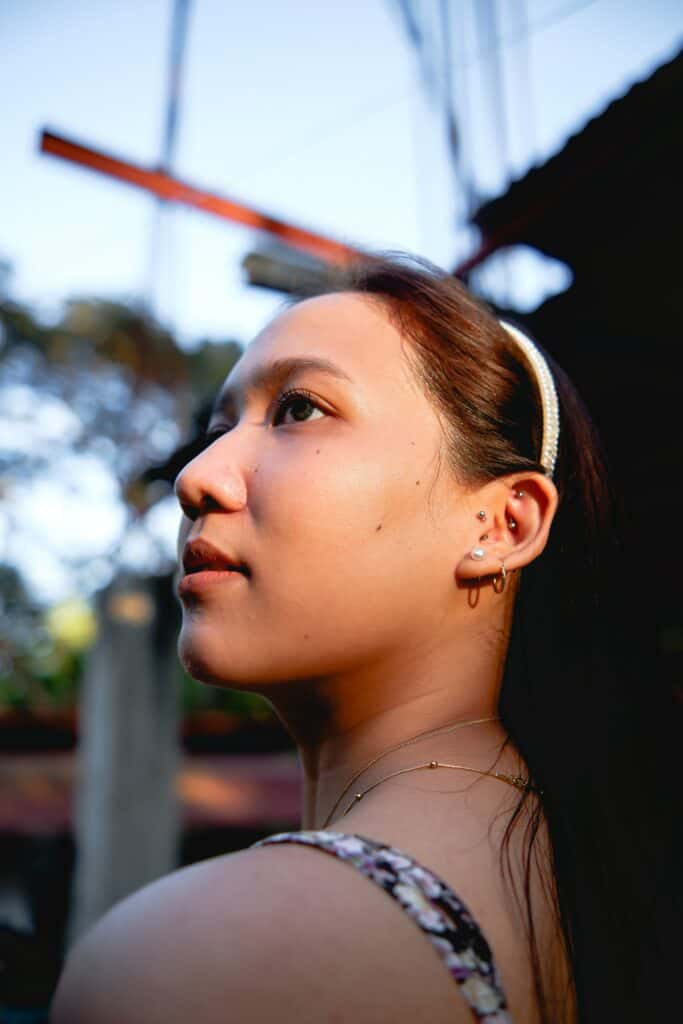
4. Daith piercing
The next piercing on our pain list is the daith piercing. With a pain score of six out of 10, it is definitely worthy of mention. With this piercing, a gem is placed through the cartilage where your inner ear meets your outer ear. Placing a daith piercing takes quite a long time because it requires piercing well through the cartilage. Therefore, if you have a thicker cartilage, it will take longer to pierce it. So this also means that the pain of piercing will last longer.
So what specifically can you expect in terms of pain during the piercing process? Well, many talk about a dull pain and weird pressing sensation on the ear. This pain fortunately subsides completely after a few hours. Of course, the piercing will remain sensitive for several weeks, but with proper care, it will heal well. After 8 weeks you can have the initial jewel replaced with a nice jewel of your choice. Here are some fun ideas for inspiration: a ring with glitter, a heart-shaped hoop or a ring in a bright color.
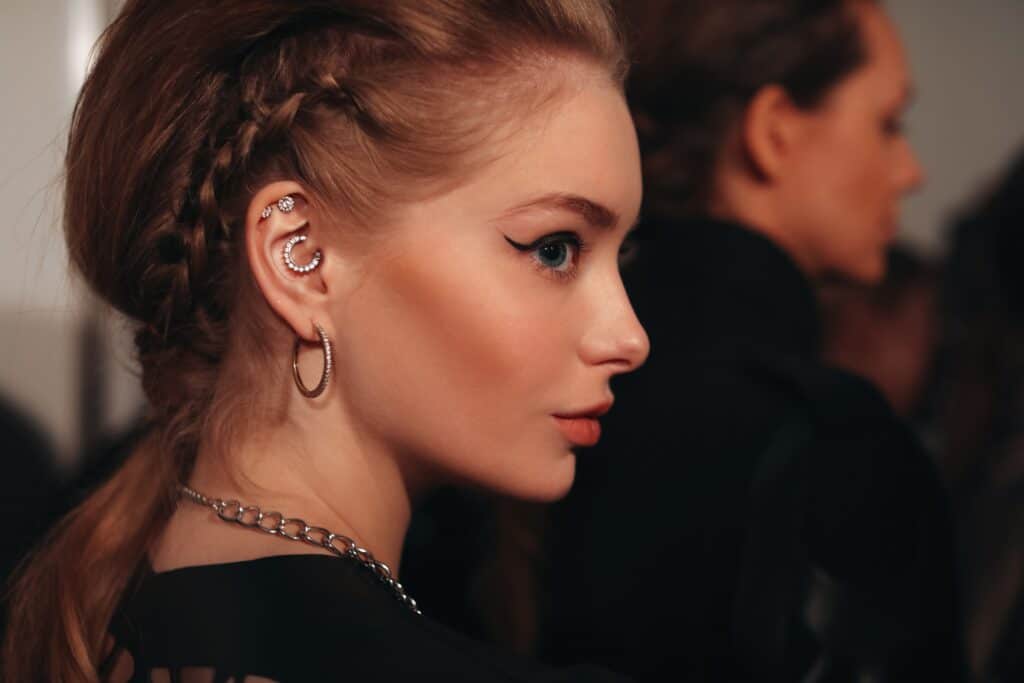
5. Conch piercing
Halfway down our list, we have the conch piercing. This piercing scores a five out of ten as a pain score. During the piercing, you will experience an oppressive pain, but that feeling passes fairly quickly. As with all piercings, it is important that you follow the aftercare instructions carefully in order to obtain a beautiful and healed piercing. With this piercing there is an extra, namely that you should not wear earphones during the healing process.
A conch is unfortunately not feasible for everyone, and depends heavily on the amount of space you have in your auricle. This popular piercing can be pierced in two different places. With the inner conch, we pierce horizontally in deepest part of your auricle. An outer conch piercing is placed on the flat, upper part of your ear. Both variations are nice and eye-catching and super beautiful with a decorative gem. Some choose to replace their inner conch with a ring. If you cannot do this because your cartilage is too large, there is another solution. You can easily connect the front of your stud with a chain to the back. This way you still have the effect of a ring.
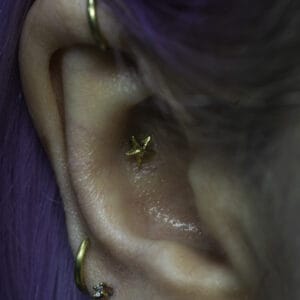
6. Tragus piercing
In sixth place we then have the tragus piercing with a pain score of five out of ten.
A tragus is a piercing in which one will pierce the cartilage just beside the opening of your ear. A tragus is not the same as an anti-tragus. With an anti-tragus, we are going to pierce the cartilage just beyond your earlobe. This one especially hurts if you don't have much room.
During piercing, you will feel that dull pain again, but it will pass quickly. During the healing process, however, it is important to watch out for hair or dust with this piercing. These things can easily stick to the piercing, which can cause unwanted inflammation. A tragus is a piercing that stands out quickly and that you can fully personalize with a fun colored ball or a small ring.
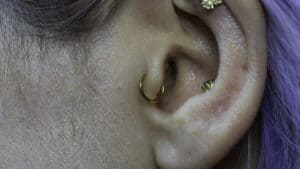
7. Flat piercing
A flat piercing is located at the top of the flat part your ear. It is fine cartilage, but many find that it just hurts more than thick cartilage. As a result, a flat gets a pain score of four out of ten.
This piercing is a nice extra that you get pierced in your ear, but you have to be careful with it. During aftercare, it is important that you do not wear headphones for a while and that you make sure that no hair gets caught in the piercing. Furthermore, it is also best to sleep on the other ear for a while.
With a flat piercing, it is not possible to place a ring. However, it is a nice place for eye-catching and colorful gems.
8. Lip piercing
A lip piercing can be very sexy, but also very painful. Lower lip piercings hurt less and get a score of three out of ten. But an upper lip piercing gets a pain score of six out of ten from us. Angelbites, a medusa piercing and a Monroe piercing, are some well-known upper lip piercings that can feel vicious when placed.
With most piercings, you need to start taking into account the clothing you put on during aftercare to prevent any inflammation. With a lip piercing you should also take into account what you eat and drink in the first few weeks. Hot drinks and meals are not recommended and it is best to rinse your mouth after each consumption.
9. Nose wing piercing
A nostril piercing comes to us in ninth place. This type of piercing can be quite painful for many people. In the nostril we are going to pierce through cartilage. During the piercing, you will have a similar feeling to the way someone slowly pulls out a nose hair. It stings very hard and you will undoubtedly have some tears. Of course everyone's body is going to react differently to this. There are often people who feel almost nothing.
Furthermore, it is important that you follow the aftercare measures of your piercer in order to get a nice healed nose piercing. After a few weeks you can then exchange your nasal piercing for a nice ring or colored stone.

10. Helix piercing
A helix is a very popular piercing that can be quite painful for some. Others find it more of a short pinching prick. Our piercers give the helix a pain score of three out of ten. A helix is pierced at that top edge of your ear. You can choose 1 helix, several underneath each other or in a different place such as a forward helix.
During piercing, you will experience a brief pinching sensation but once the gem is in, this is immediately over. This piercing has a difficult healing process and so there are some things you need to take into account. With a helix piercing you have to be especially careful that no hair or clothing gets stuck to your gem. So if you want to listen to music, it is better to swap your headphones for a pair of earphones. Preferably also sleep a few nights on the other ear. If you don't do this, infections or inflammations can develop, and that's not pleasant. After you have kept this up for a while, your helix will be completely healed. After this, you can start replacing your starting gems with a ring of your choice.
Which piercings hurt the least?
Even if you wouldn't think so right away, genital piercings are on this list! Apparently, these really don't hurt much in women. You will no doubt notice a pinching sensation, but that is normal with a piercing. In men, then, it's a different story. These types of piercings can be really painful for men.
Dermal piercings really don't hurt much either. A dermal is a piercing that you can have placed anywhere on your body. They are small implants that stay in place very easily thanks to a super small anchorage. Some popular places include: the wrist, neck, middle of the lower lip and on the cheekbones.

A tongue piercing Also hurts surprisingly little. The tongue is a sponge and the piercing needle sinks through it very easily. The tongue is made up of 2 muscles and when you tighten them due to stress, they go towards each other and so this piercing can hurt a bit. So no stress and relax!
An ordinary nose piercing may well hurt, but a septum not. This piercing goes through a membrane, and not through cartilage as many may think. Because the piercing goes through a membrane, you feel almost nothing about it.
Last on the painless list there is, a navel piercing. When this piercing is placed using forceps, it can be quite painful. You can avoid this by going to a professional piercer. At Inksane, we do not use a clamp and use the correct technique which makes this piercing feel almost painless.
How can you reduce piercing pain?
Unfortunately, there are no products on the market that will reduce the pain of piercing. Geez! We do not recommend using any kind of numbing cream. This ointment is going to make the skin very plastic and that is not optimal to work on. If we see that numbing cream has been used anyway, we will unfortunately have to reschedule your appointment.
The best thing you can do is just unwind and come to your appointment relaxed. At Inksane, our piercers work under the rules of the APP (Association of Professional Piercers). They are each masters of their craft and will do their best to make the experience as painless as possible.
The nipple piercing will remain at number one as the most painful piercing. Other piercings can also be quite painful but the pain you will experience depends entirely on your personal pain threshold and the experience of your piercer. So make a good choice and choose Inksane Piercing to make all your piercing wishes come true. Are you already itching to get one of the above piercings? Then don't hesitate to make an appointment through our piercing website.



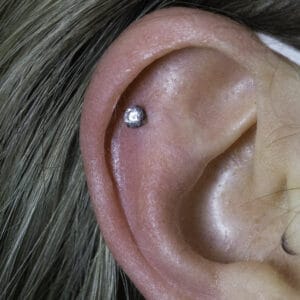
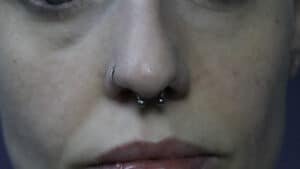
Getting an umbilical piercing with a 'tank' also seems pretty painful to me 😂
Ouch... and this comment too LOL. Updated on this one, thx!
My naval piercing in terms of pain was a 9 . Daith . Tragus . Conch . All a 1 . Felt almost nothing . Now I doubt I'm going to get another double forward helix
Hi!
How much a piercing will hurt depends mainly on the pain threshold of the person himself, some people can already withstand a bigger bump than others. As you describe it, cartilage piercings don't hurt much. The forward helix is very similar in pain level to a "classic" helix or a conch. We also try to hurt our clients as little as possible through the materials and techniques we use (like the sharpest needles we can find so the piercing goes smoothly for example). Feel free to visit one of our piercers, and we'll be happy to provide the extra bling in your ear :)
How can t it be that I have had a targus puercing done 3 times already and always eradicated within 3 mnd?
Hi Angelique
This can depend on several factors. Unfortunately, not everyone has the anatomy for a tragus piercing, so this can definitely play into it. Of course, the way it is placed is also important, along with the aftercare of your piercing. From a distance, we can hardly give a sure cause for this. If you would like to have one of our piercers take a look at this, you are certainly welcome :)